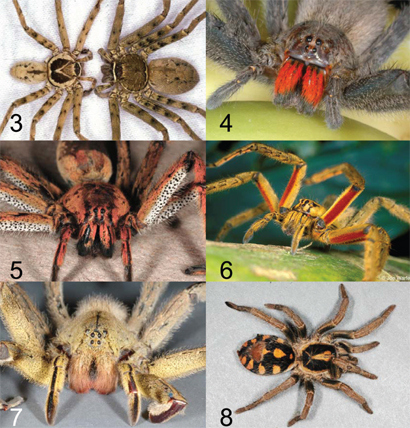New Study Provides Key to Identifying Spiders in International Cargo

Figs. 3–8. (3) Male (left) and female (right) pantropical huntsman spiders, H. venatoria (Sparassidae). Identifying feature: white “moustache” on clypeus, male with characteristic markings. (4) Female redfaced banana spider, C. chiapanensis (Ctenidae). Identifying feature: bright red setae on basal 3/4ths of chelicerae. (5) Female spotlegged banana spider, C. getazi (Ctenidae). Identifying feature: black spots on white background on all ventral femora. (6) Redlegged banana spider, C. coccineus (Ctenidae). Identifying feature: red setae on ventral femora of front legs (photo by J. Warfel). (7) Female P. boliviensis (Ctenidae). Note: coloration of red cheliceral hairs is diffused. (8) Hapalopus sp. (Theraphosidae). All photos by Richard Vetter unless otherwise noted.
In 2006, after witnessing multiple episodes where harmless spiders were mistaken for toxic ones, Richard Vetter, an arachnologist at the University of California, Riverside, asked other arachnologists and international fruit importers to provide data on specimens they found in international cargo that had been submitted to them for identification. He also asked that they identify spiders in their museum collections that had previously been found in cargo.
Together with colleagues from Canada and Washington State, Vetter identified 135 spiders taken from international cargo between 1926 to June 2014, which they describe in an ad hoc study in the Journal of Medical Entomology.
The authors hope that their paper will fill a knowledge gap and facilitate the proper identification of cargo-borne spiders because misidentifications can lead to costly and unwarranted eradication measures, unnecessary employee health education, heightened employee anxiety, and spoilage when perishable goods are left unloaded due to safety concerns.
In order to help avoid misidentifications in the future, the new paper contains a simple key that covers the most common non-mygalomorph spiders found in their study.
“This key should provide some utility for those confronted with a spider found in international shipments,” they wrote.
The authors found that the most frequently submitted spiders were the pantropical huntsman spider (Heteropoda venatoria) and the redfaced banana spider (Cupiennius chiapanensis), and that the most common cargo from which spiders were submitted was bananas, with most specimens coming from Central America, Ecuador, or Colombia.
Spiders of medical importance were rare.
“Spiders found in international cargo, especially those in banana cartons, are typically harmless species,” they wrote. “It would be beneficial if this article curtails the hyperbole and media attention whenever a large spider is discovered in a banana shipment, and thereby, reduce unwarranted paranoia and anxiety when media stories about toxic banana spiders are unleashed onto an unsuspecting and easily frightened North American general public.”
Media Contact
All latest news from the category: Ecology, The Environment and Conservation
This complex theme deals primarily with interactions between organisms and the environmental factors that impact them, but to a greater extent between individual inanimate environmental factors.
innovations-report offers informative reports and articles on topics such as climate protection, landscape conservation, ecological systems, wildlife and nature parks and ecosystem efficiency and balance.
Newest articles

Superradiant atoms could push the boundaries of how precisely time can be measured
Superradiant atoms can help us measure time more precisely than ever. In a new study, researchers from the University of Copenhagen present a new method for measuring the time interval,…

Ion thermoelectric conversion devices for near room temperature
The electrode sheet of the thermoelectric device consists of ionic hydrogel, which is sandwiched between the electrodes to form, and the Prussian blue on the electrode undergoes a redox reaction…

Zap Energy achieves 37-million-degree temperatures in a compact device
New publication reports record electron temperatures for a small-scale, sheared-flow-stabilized Z-pinch fusion device. In the nine decades since humans first produced fusion reactions, only a few fusion technologies have demonstrated…





















